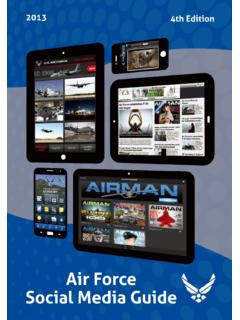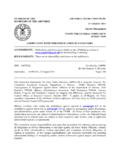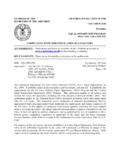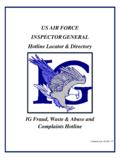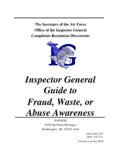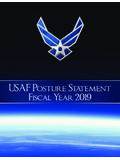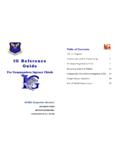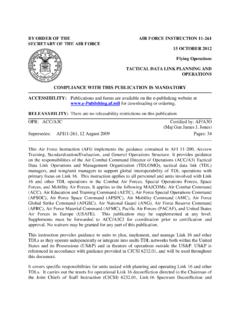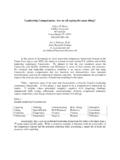Transcription of May 2015 1 - af.mil
1 1 May 2015 2 Foreword Airmen and Airpower Advocates, This 20-year Strategic Master Plan advances the strategic vectors and imperatives set by America s air force : A Call to the future to provide a strategic framework that will shape the air force s future . It provides consistent direction across all air force portfolios and brings year-to-year coherency to our plans and programs. However, the changes we need to enact are wider than just choices about equipment programs. Our Airmen are essential to all our capabilities and we must deliberately plan and invest in them to meet the challenges of the future . We must be more flexible in our posture at home and overseas. We must align our science and technology efforts with innovative concepts and capability development that will offer the opportunity to dominate in the future environment we envision and adapt rapidly when it changes. These aspects are covered in the four annexes to this plan, which provide actionable tasks to air force commands and agencies.
2 The Strategic Master Plan does not stand alone. It is at the center of a fully revised air force Strategy, Planning and Programming Process, which enables us to make strategy-informed resource decisions. Programmers and planners at air force Headquarters and Major Commands are the primary audience for this document. The Strategic Master Plan fills a void in strategic direction and will reduce the need for many existing strategic plans currently issued by various headquarters and organizations. It will be complemented by an air force future Operating Concept document that will describe how we will deliver Global Vigilance, Global Reach and Global Power in agile and innovative ways appropriate for the future we face. These documents certainly do not reflect the sum total of all strategic planning efforts across our air force . There are significant planning documents created by the functional staffs, MAJCOMs, and Core Function Leads that are critical to form a comprehensive plan.
3 It is imperative, however, that these Core Function Support Plans and Flight Plans are consistent with the direction in this plan. Finally, bear in mind that this plan is long-term and iterative, and will be updated regularly. We need your help to improve and refine the plan as conditions and priorities dictate. We must apply discipline and adjust to the world around us; only through your efforts can this plan succeed. Deborah Lee James Secretary of the air force Mark A. Welsh III General, USAF Chief of Staff 3 Executive Summary This Strategic Master Plan (SMP) translates the United States air force s 30-year strategy, America s air force : A Call to the future , into comprehensive guidance, goals, and objectives. The complete SMP consists of a core narrative, goals, objectives, and four annexes: the Human Capital Annex (HCA), Strategic Posture Annex (SPA), Capabilities Annex (CA), and the Science and Technology Annex (STA). The core SMP will be updated every two years, while the annexes may be revised annually, as required.
4 The SMP s primary audience includes the Headquarters air force (HAF) staff, the air force Major Commands (MAJCOMs), and the Core Function Leads (CFLs) that reside within the MAJCOMs who are responsible for planning, programming and budgeting. However, guidance in the SMP also serves as authoritative direction for all air force programs and Flight Plans. The SMP aligns long-range air force strategy, policy, and guidance with planning and programmatic decisions of senior air force leadership in support of National Defense and Combatant Command requirements. It does this by prescribing broad goals and objectives that help guide development of plans throughout the Strategy, Planning, and Programming Process (SP3) and associated inputs to the Joint Capabilities Integration Decision System (JCIDS) and Planning, Programming, Budgeting, and Execution (PPBE) systems. As described in the air force Strategy, the air force must aggressively pursue a path that leads to the institutional strategic agility required to adapt and respond faster than our adversaries in an increasingly dynamic environment characterized by constrained resources.
5 Although the core SMP does not specify priorities for investment or divestment, its imperatives and vectors provide shared understanding that empowers air force senior leaders to align interests and reach consensus in the face of difficult planning choices. The priorities expressed in the four annexes provide a framework to guide HAF, MAJCOM, and CFL staffs as they build balanced options for the air force within the SP3. The air force will increase Agility by strengthening our culture of adaptability and innovation in Airman development and education, capability development, operational training and employment, and organizations. To increase our Inclusiveness, we must focus on empowering the members of the air force Team, improving the structure and culture that populates it, and expanding our connections both outside and within the Service. The air force Strategy s five strategic vectors identify priority areas for investment, institutional change, and operational concepts: 1.
6 Provide Effective 21st-Century Deterrence: The nuclear mission remains the clear priority of air force leaders, but the air force also offers many additional capabilities to deter a wide range of actors. 2. Maintain a Robust and Flexible Global Intelligence, Surveillance, and Reconnaissance (ISR) Capability: The air force will employ agile multi-domain solutions to detect, characterize, deter, and defeat adversaries. This requires an agile, coordinated multi-domain ISR approach that provides commanders with multiple options. 3. Ensure a Full-Spectrum Capable, High-End Focused force : The air force must focus on the skills and capabilities that deliver freedom of maneuver and allow decisive action in highly-contested spaces. However, we must retain the ability to succeed in low-intensity conflict. 4 4. Pursue a Multi-Domain Approach to our Five Core Missions: To achieve the most effective solutions across the spectrum of military operations, we will increasingly integrate and employ capabilities operating in or through the cyberspace and space domains in addition to air capabilities.
7 5. Continue the Pursuit of Game-Changing Technologies: We must continue to pursue radical improvements in technology, that when combined with new approaches and organizational changes, expand or maintain asymmetric advantages over adversaries. This requires the identification and harvesting of potential breakthroughs in thinking that might amplify the enduring effects that underpin our advantages in air, space, and cyberspace. By establishing a core strategic approach that spans the air force , the SMP represents a significant shift in the way the air force conducts its business. As subsequent iterations of the SMP inform and are informed by annual Planning Choices events and ongoing Service-wide activities to organize, train, and equip the Service, the structure and content of this document will evolve to best articulate the air force s long-range strategic plan. 5 Contents Foreword .. 2 Executive Summary .. 3 Introduction .. 7 Background and Purpose .. 7 Scope and Structure of the Strategic Master Plan.
8 8 Figure 1: Internal Structure of the SMP .. 9 Figure 2: The SMP within the Strategy, Planning, and Programming Process (SP3) .. 10 Assessment and Revision .. 11 Assumptions .. 11 Risk .. 11 Terms and Definitions .. 11 Figure 3: Objective Naming Convention .. 12 Strategic Imperatives .. 13 IMPERATIVE: AGILITY .. 13 Development and Education .. 13 Capability Development .. 14 Operational Training and Employment .. 16 Agile Organizations .. 17 Table 1: Goal and Objectives Supporting Agility .. 19 IMPERATIVE: INCLUSIVENESS .. 25 Structure of the air force Team .. 25 air force Culture .. 26 Partnerships .. 27 Table 4: Goal and Objectives Supporting Inclusiveness .. 30 Strategic Vectors .. 36 VECTOR: PROVIDE EFFECTIVE 21ST-CENTURY DETERRENCE .. 37 Strategic Nuclear Deterrence .. 37 Deterring Other Strategic Attacks .. 37 Table 7: Goal and Objectives Supporting Deterrence .. 39 VECTOR: MAINTAIN A ROBUST AND FLEXIBLE GLOBAL INTEGRATED INTELLIGENCE, SURVEILLANCE AND RECONNAISSANCE CAPABILITY.
9 41 Table 8: Goal and Objectives Supporting ISR .. 43 6 VECTOR: ENSURE A FULL-SPECTRUM-CAPABLE, HIGH-END-FOCUSED force .. 45 Table 9: Goal and Objectives Supporting a Full-Spectrum, High-End-Focused force .. 49 VECTOR: PURSUE A MULTI-DOMAIN APPROACH TO OUR FIVE CORE MISSIONS .. 53 Table 11: Goal and Objectives Supporting a Multi-Domain Approach .. 57 VECTOR: CONTINUE THE PURSUIT OF GAME-CHANGING TECHNOLOGIES .. 59 Table 12: Goal and Objectives Supporting Game-Changing Technologies .. 62 Glossary .. 64 ANNEX A - HUMAN CAPITAL ANNEX B - STRATEGIC POSTURE ANNEX C - CAPABILITIES ANNEX (S)..C-1 ANNEX D - SCIENCE & TECHNOLOGY ANNEX (S/NF)..D-1 7 Introduction Background and Purpose In the 2014 air force Strategy, entitled America s air force : A Call to the future , the United States air force outlines its 30-year strategy to address a future environment characterized by uncertainty and change. The following Strategic Master Plan (SMP) operationalizes the air force Strategy by providing authoritative direction that informs Service-wide planning and prioritization on a 20-year timeline.
10 The 2014 air force Strategic Environment Assessment (AFSEA) identified four areas where emergent threats to our current world model are likely to provoke profound and rapid change over the next 20 years: Geopolitics Natural resources Challenges to the Global Commons Speed of technological change To provide for a robust national defense and field suitable capability and capacity in support of joint operations, the air force will pursue systems, concepts, people, and organizational structures that are more agile and inclusive. The air force Strategy addresses this need by expounding these two strategic imperatives to drive a culture change. To focus our efforts in making tough choices about future capabilities, the Strategy further identifies five strategic vectors. These vectors will guide investments, institutional changes, employment concepts, and ultimately shape efforts to deliver national security through the strength of our Airmen and the responsive and effective application of Global Vigilance-Global Reach-Global Power for America.

